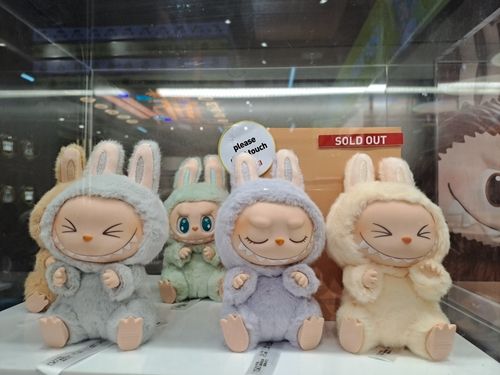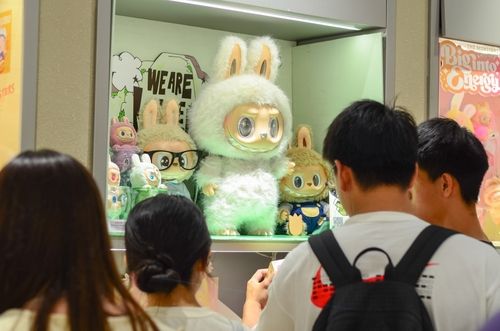Labubu – ever thought a toy could become as valuable as currency? Sounds wild, but it’s true. These creepy-cute collectibles, hidden inside “blind boxes” that keep their design a mystery, have gone from niche toys to a global obsession.
In 2024 alone, Pop Mart, the Chinese company behind Labubu, reported total revenue of over $1.8 billion – a 7x jump since 2019. Labubu dolls contributed significantly to this, bringing in around $423 million in 2024 alone, marking a 729% jump from 2023.
This tiny toy that captured the world’s imagination has not only made collectors richer but also turned Pop Mart’s founder, Wang Ning, into one of China’s youngest billionaires.
Since listing on the Hong Kong Stock Exchange in 2020, Pop Mart’s stock market valuation has surged nearly 600% in the past year.
Source: Pop Mart
What is Labubu, and why is everyone talking about it?
Labubu is part of The Monsters, a fictional group created by Dutch-born Hong Kong illustrator Kasing Lung. First introduced in his 2015 picture book series The Monsters Trilogy, Labubu comes from Nordic mythology-inspired tales.
Described as an “elvish creature” who’s kind-hearted but often accidentally causes chaos, Labubu has distinctive bunny ears and a cheeky grin that fans can’t resist. Pop Mart, the Chinese collectibles giant, turned this quirky character into a doll, and suddenly, what started as a simple storybook creature is now a global icon everyone wants their hands on.

Source: Shutterstock
How much do Labubu dolls cost?
Thinking of adding a Labubu to your collection? Here’s what you need to know. If you buy directly from Pop Mart, prices are relatively accessible:
Vinyl dolls start at around $15.
The most popular Labubus – the plush bag charms – cost between $20 and $30.
But if you’re eyeing a 31-inch vinyl figure, be ready to spend over $900.
That’s retail. But the real frenzy begins in the resale market. On third-party platforms like eBay and StockX, prices skyrocket – especially for rare pieces. It’s not unusual to see Labubus selling for hundreds or even thousands of dollars. Just how high can it go?
In June 2025, a life-size, four-foot Labubu doll sold for over $170,000.
Another five-foot-tall Labubu went for more than $130,000 at an art show collection.
How scarcity-driven hype cycles shape consumer demand and market perception?
(Case study on strategy adopted by Pop Mart)
Pop Mart didn’t just sell toys – it sold mystery, exclusivity, and emotional investment. Their blind-box model, launched in 2016, turned ordinary purchases into a psychological game.
Here’s how it works:
Consumers buy sealed boxes without knowing which figure is inside. For popular characters like Labubu, each blind box offers six possible designs and a rare “secret” variant with only a 1-in-72 chance of unboxing it.
The results?
Surprise and thrill keep fans coming back for more.
Artificial scarcity makes limited editions sell out within minutes, creating urgency and FOMO.
Resale market boom, where rare Labubus fetch hundreds or thousands of dollars on eBay and StockX.
But how much does it really cost to get these rare pieces?
According to CNN, buying enough boxes to finally find a secret variant can get expensive. Their simulation showed that, on average, a buyer might end up spending around $2,000 before unboxing one.
This strategy goes beyond just the product. Pop Mart fuels hype through timed drops, pop-ups and vending machines that reinforce scarcity, and viral unboxing videos by influencers and celebrities like Blackpink’s Lisa.
All these tactics elevate Labubu from a toy to an aspirational collectible. In 2024, Pop Mart reported a 188% year-on-year net income increase, with full-year sales exceeding ¥13 billion.. Thirteen of its IP products, including Labubu, generated over ¥100 million each.
Case studies showing scarcity in play
Liquid Death
It turned water into a badge of rebellion. In 2018, founder Mike Cessario launched a fake Facebook page with an edgy video ad that racked up 3 million views and 80,000 followers in four months, surpassing Aquafina and creating massive FOMO before launch. Sales then jumped from $2.8 million in 2019 to $45 million in 2021, and hit $130 million in 2022.
With skull-branded cans, limited-edition collabs, and shocking campaigns like “Murder Your Thirst”, Liquid Death made consumers feel left out if they weren’t part of its cult-like movement. The brand raised $189 million over 8 funding rounds, reached a $700 million valuation, and saved 100 million plastic bottles from polluting the planet.
Prime Hydration
Prime Hydration, launched by Logan Paul and KSI, used scarcity-driven hype effectively. Limited stock drops saw £2 bottles resold for £15–£20 in UK supermarkets.
Videos of empty shelves went viral, fuelling FOMO. In its first year (2022), Prime recorded $250 million in sales, proving how urgency and influencer buzz can turn a simple drink into a cultural phenomenon.
OnePlus
OnePlus built its brand on invite-only sales, making buyers feel part of an exclusive club. For its first phone, the OnePlus One (2014), the company adopted an invite-only system, selling over 1.5 million units globally within the 1st year despite targeting an initial goal of just 50,000 units. This strategy not only cut marketing costs but created intense anticipation and brand loyalty.
The dark side of scarcity marketing
“A hungry man can’t see right or wrong. He just sees food,” wrote Pearl S. Buck.
She might have said this with a direct intention, but look closer – its metaphorical roots reach into today’s digital marketing world. Enter: scarcity marketing.
Think of those banners screaming:
“Limited Period Offer!”
“Only a few pieces left!”
“Sale like never before!”
It works because it taps deep into human instincts for urgency and exclusivity. But here’s the flip side.
When urgency turns manipulative
“At its worst, scarcity marketing can manipulate consumer behaviour through deceptive tactics, leading to financial harm, distrust, and even legal trouble,” warns Jay Rathod, founder and CEO of Koffeetech Communications.
One common malpractice? Falsely labelling products as “low in stock” or using countdown timers that reset indefinitely.
These strategies prey on FOMO (fear of missing out), compelling shoppers to buy without proper consideration.
A HubSpot survey backs this up: 60% of consumers act on purchases because they fear missing out. But here’s what actually builds loyalty. According to Label Insight, 94% of consumers stay loyal to brands offering full transparency.
The see-saw between finance and psychology
Deceptive scarcity doesn’t just harm trust – it can dent wallets. Impulse purchases driven by false urgency often lead to buyer’s remorse. People realise they’ve spent on things they didn’t need or were misled into buying.
The fallout? 59% of customers stop buying from a company after multiple bad experiences. 17% leave after just one, reveals a PwC survey.
The ethical dilemma in scarcity marketing is balancing urgency with honesty. While urgency drives sales, tactics like exaggerating low stock or false countdowns can erode trust. As Bain & Company found, increasing customer retention by just 5% can boost profits by 25-95% – proving that long-term loyalty beats short-term tricks.
Final thoughts
Labubu shows how a simple toy can spark billion-dollar hype, turning scarcity into desire and mystery into money. But behind every sold-out drop and viral unboxing lies a question: Does urgency build community or just prey on FOMO? When done right, scarcity marketing can create excitement and loyalty – as long as it stays honest and consumer-focused.
Disclaimer: This article is for informational purposes only and must not be considered investment advice. Investors should consult with experts before making any investment decisions.


